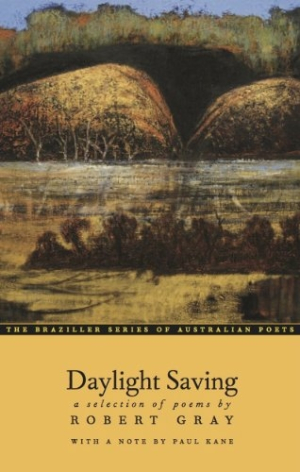Daylight Saving
Encounters with serene landscapes, ordinary occurrences, and thoughtful rural people ignite a desire to search within oneself and connect to the world.
From an author regarded as crucial and distinguished among Australian poets of his generation, Daylight Saving includes work from 1965 to 2005 and is presented to American audiences in the inaugural edition of the Braziller Series of Australian Poets. While Robert Gray’s reputation is known by some, others will read him for the first time to find something riveting and genuine.
Gray’s is a beautiful and devastating encounter with landscapes and seascapes and skies, where he also finds a form of consolation. Thus, observations about nature’s realness converge with an erudite consciousness to form a cornerstone of the collection. And yet, not much happens in these poems. Instead, Gray narrates, in his inimitable, clear-sighted style, simply what is; how the world around him looks, smells, and feels on the skin.
Schooled but not scholarly in tone, Gray references writers and influences including Heraclitus, Whitman, Borges, Rilke, and especially Zen Master Dogen. Gray seems steeped in the tradition of Buddhist thought and poetry, although not as one who emulates but instead who offers a deft combination of affinity and something utterly his own. For instance, Gray paraphrases the venerable Zen master, with whom he shares an appreciation for careful attention to the common elements of daily life: “He said, All that’s important / is the ordinary things: // making a fire / to boil the bathwater, pounding rice, pulling weeds / and knocking dirt from their roots, // or pouring tea (those blown scarves, / a moment, more beautiful than the drapery / in paintings by a master.)”
These are personal poems, written from a deeper chamber of the self, expressing the most private visions and feelings. Gray’s other subjects include the ways of rural people and fishermen, times of day, light, aging, and even his mother’s struggle with Alzheimer’s.
In a number of key poems, long lines—patient, unhurried, even prose-like in their syntax—take off across the page so that even the ambivalent reader becomes inundated with Gray’s exacting description. This approach to pages serves to persuade the reader through a strategy of immersion; if the reader resists, he or she is eventually overcome by images rendered with the precision of a painter. To read Robert Gray is to sense and see with renewed vividness, as if there had been a scrim or barrier between ourselves and the world, and he has restored us to it by tearing away the separation.
Reviewed by
Holly Wren Spaulding
Disclosure: This article is not an endorsement, but a review. The publisher of this book provided free copies of the book to have their book reviewed by a professional reviewer. No fee was paid by the publisher for this review. Foreword Reviews only recommends books that we love. Foreword Magazine, Inc. is disclosing this in accordance with the Federal Trade Commission’s 16 CFR, Part 255.

